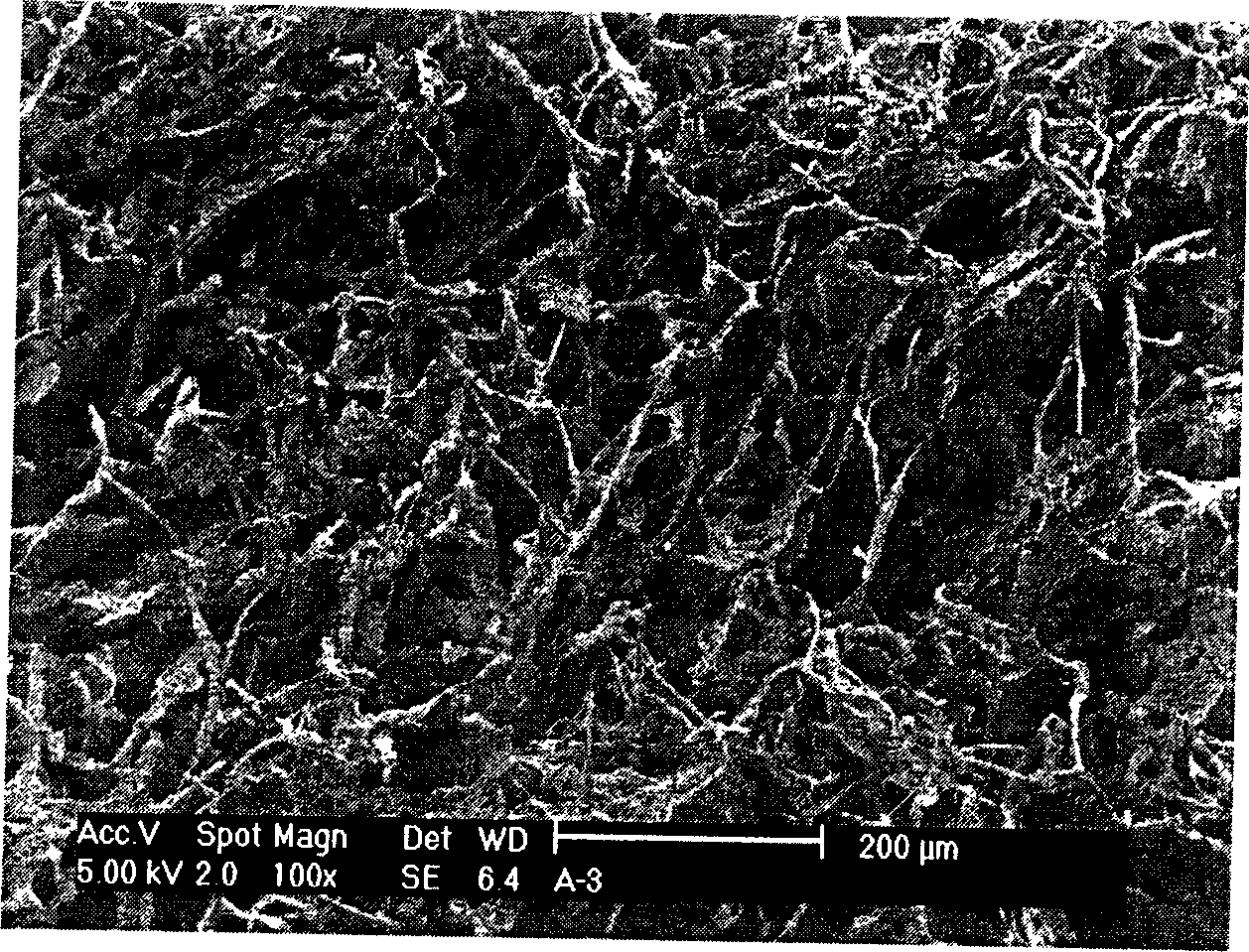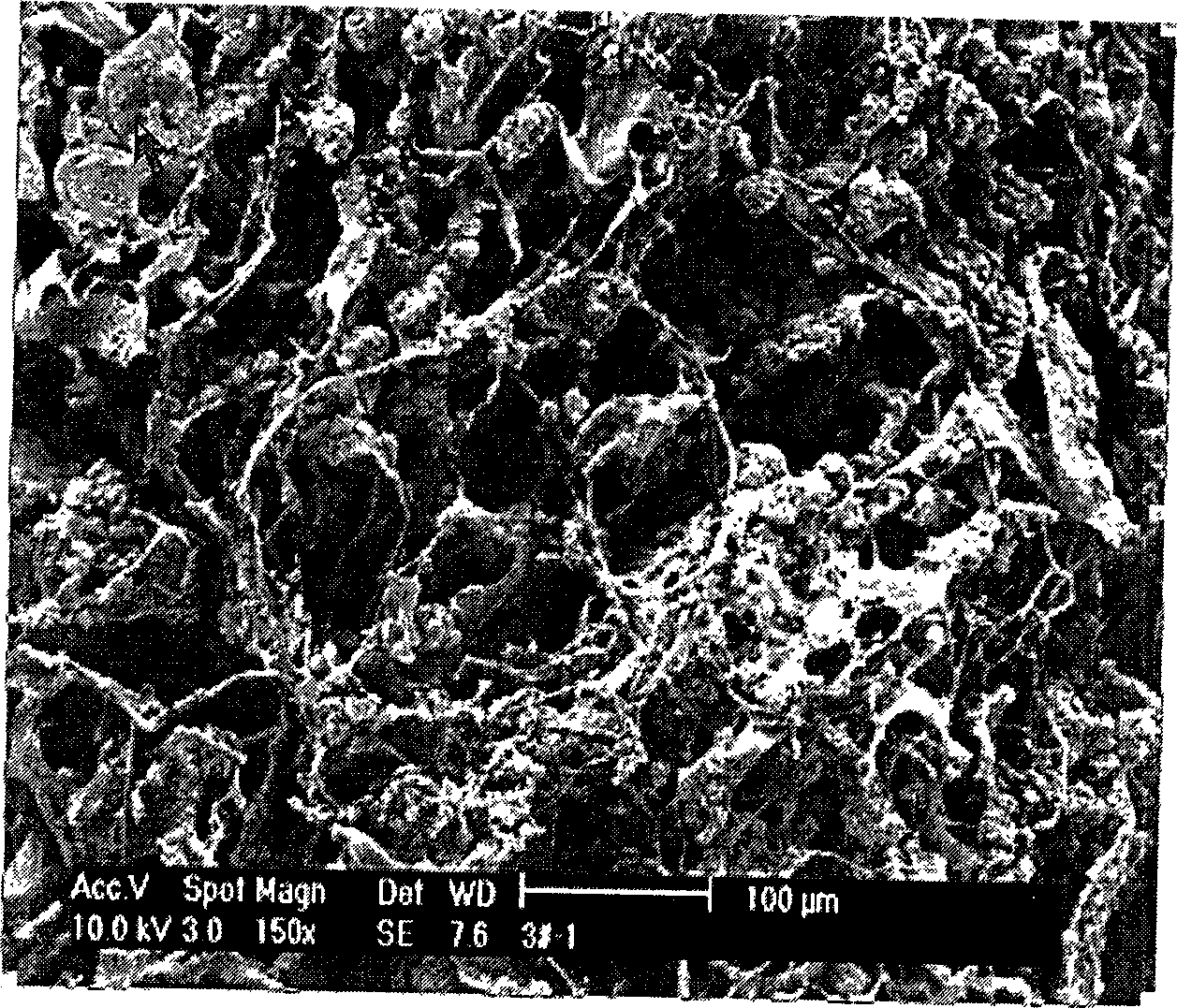Composite tri-dimensional porous bone tissue engineering stent material and its preparation method and uses
A technology of bone tissue engineering and scaffold material, applied in the field of biomedical materials, can solve the problems of destroying the degradation performance of calcium phosphorus ceramics, difficult body degradation, poor clinical operability, etc., and achieve good osseointegration and cell affinity, high Bioactivity and biocompatibility, effects of altering structure and mechanical strength
- Summary
- Abstract
- Description
- Claims
- Application Information
AI Technical Summary
Problems solved by technology
Method used
Image
Examples
Embodiment 1
[0039] (1) Preparation of CaO-P 2 o 5 -SiO 2 System bioactive glass nanopowder
[0040] (1) Preparation of microemulsion organic template: add octylphenol-based polyoxyethylene ether (TritonX-100), co-surfactant and ammonium hydroxide aqueous solution (concentration 12.5%) or calcium nitrate aqueous solution (concentration 12.5%) in cyclohexane 0.6M), prepare the microemulsion of ammonium hydroxide solution and the microemulsion of calcium nitrate solution;
[0041] (2) Hydrolysis: adding tetraethyl orthosilicate (TEOS) and triethyl phosphate (TEP) to the microemulsion of ammonium hydroxide solution, a hydrolysis reaction occurs, and the hydrolysis reaction time is 30 to 60 minutes. (TEOS): triethyl phosphate (TEP): the weight ratio of ammonium hydroxide aqueous solution is 9: 1: 50;
[0042] (3) mixing: the microemulsion of the calcium nitrate solution configured in step (1) is added in the microemulsion obtained in step (2) by volume ratio 1: 1, and stirred for 60 minute...
Embodiment 2
[0050] (1) Preparation of CaO-P 2 o 5 -SiO 2 System bioactive glass nanopowder
[0051] (1) Preparation of microemulsion organic template: add octylphenol-based polyoxyethylene ether (TritonX-100), co-surfactant and ammonium hydroxide aqueous solution (concentration 12.5%) or calcium nitrate aqueous solution (concentration 12.5%) in cyclohexane 0.6M), prepare the microemulsion of ammonium hydroxide solution and the microemulsion of calcium nitrate solution;
[0052] (2) Hydrolysis: adding tetraethyl orthosilicate (TEOS) and triethyl phosphate (TEP) to the microemulsion of ammonium hydroxide solution, a hydrolysis reaction occurs, and the hydrolysis reaction time is 30 minutes. ): triethyl phosphate (TEP): the weight ratio of ammonium hydroxide aqueous solution is 13: 1: 100;
[0053] (3) mixing: the microemulsion of the calcium nitrate solution configured in step (1) is added in the microemulsion obtained in step (2) by volume ratio 1: 1, and stirred for 80 minutes to obta...
Embodiment 3
[0061] (1) Preparation of CaO-P 2 o 5 -SiO 2 System bioactive glass nanopowder
[0062] (1) Preparation of microemulsion organic template: add octylphenol-based polyoxyethylene ether (TritonX-100), co-surfactant and ammonium hydroxide aqueous solution (concentration 12.5%) or calcium nitrate aqueous solution (concentration 12.5%) in cyclohexane 0.6M), prepare the microemulsion of ammonium hydroxide solution and the microemulsion of calcium nitrate solution;
[0063] (2) Hydrolysis: adding tetraethyl orthosilicate (TEOS) and triethyl phosphate (TEP) to the microemulsion of ammonium hydroxide solution, a hydrolysis reaction occurs, and the hydrolysis reaction time is 30 to 60 minutes. (TEOS): triethyl phosphate (TEP): the weight ratio of ammonium hydroxide aqueous solution is 9: 1: 50;
[0064] (3) mixing: the microemulsion of the calcium nitrate solution configured in step (1) is added in the microemulsion obtained in step (2) by volume ratio 1: 1, and stirred for 60 minute...
PUM
| Property | Measurement | Unit |
|---|---|---|
| Aperture | aaaaa | aaaaa |
| Diameter | aaaaa | aaaaa |
| Aperture | aaaaa | aaaaa |
Abstract
Description
Claims
Application Information
 Login to View More
Login to View More - R&D
- Intellectual Property
- Life Sciences
- Materials
- Tech Scout
- Unparalleled Data Quality
- Higher Quality Content
- 60% Fewer Hallucinations
Browse by: Latest US Patents, China's latest patents, Technical Efficacy Thesaurus, Application Domain, Technology Topic, Popular Technical Reports.
© 2025 PatSnap. All rights reserved.Legal|Privacy policy|Modern Slavery Act Transparency Statement|Sitemap|About US| Contact US: help@patsnap.com


